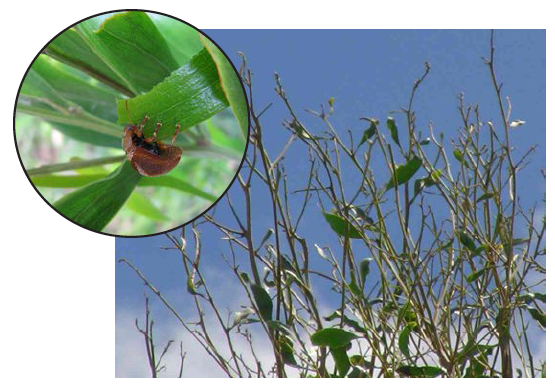PESTS AND DISEASES OF FORESTRY IN NEW ZEALAND
Dicranosterna semipunctata now in the South Island
Scion is the leading provider of forest-related knowledge in New Zealand
Formerly known as the Forest Research Institute, Scion has been a leader in research relating to forest health for over 50 years. The Rotorua-based Crown Research Institute continues to provide science that will protect all forests from damage caused by insect pests, pathogens and weeds. The information presented below arises from these research activities.
From Forest Health News 229, October 2012.
Dicranosterna semipunctata (Chrysomelidae), the blackwood tortoise beetle, is an Australian species that was first found in New Zealand at Remuera, Auckland in April 1996 on Acacia melanoxylon (blackwood). By the end of that year it had been found at Whitford and in 2001 it was found in the Waikato for the first time. By 2002 it had spread to the Coromandel and the Bay of Plenty and in 2003 it was found in Northland. In 2008 it was found in Taupo and in 2009 in Wanganui. In late September this year it was found in Nelson during High Risk Site Surveillance conducted by SPS Biosecurity.

In Australia D. semipunctata is found in Victoria, New South Wales and south east Queensland and its usual hosts are large phyllode Acacia spp. In New Zealand it is usually found on Acacia melanoxylon but it has also been recorded from A. koa, A. implexa and A. longifolia. Adults have been found feeding on Paraserianthes lophantha but it is not known if the females will oviposit on this host or if the larvae will feed on it.
Dicranosterna semipunctata can cause moderate to severe defoliation of Acacia melanoxylon and in 1999 a Scion (then Forest Research) entomologist investigated parasitoids in northern New South Wales (see FH News 105, March 2001). A tachinid larval parasitoid and two hymenopterous egg parasitoids species, Enoggera polita and Neopolycystus sp. (Pteromalidae) were found. Between 33-60% of the eggs were parasitized and this gave consideration to them being introduced to New Zealand as biological control agents. However, this was not followed up, mainly because of lack of funding.
The egg parasitoid Enoggera nassaui (Pteromalidae) and the predatory beetle Cleobora mellyi (Coccinellidae), introduced into New Zealand as biological control agents for the Eucalyptus defoliator Paropsis charybdis (Chrysomelidae), have also been considered as control agents for D. semipunctata. However, Enoggera nassaui has not been found parasitizing D. semipunctata eggs in the field although it will parasitize them in the laboratory. E. nassaui will not normally encounter D. semipunctata because it searches Eucalyptus not Acacia species.
During the summer of 2009-2010 an undescribed, self introduced species of Neopolycystus was found parasitizing D. semipunctata eggs in Auckland, Waikato and Bay of Plenty. Rates of parasitism ranged from about 6% to 78% and the parasitoid seemed to be most active in mid to late summer. This means the Neopolycystus sp. will exert pressure mainly on the second D. semipunctata generation, the adults of which feed voraciously prior to overwintering and can cause significant defoliation to A. melanoxylon.
Now that D. semipuncata is in the Nelson area, it will be interesting to see how long it takes to reach the prime A. melanoxylon growing regions on the West Coast.
John Bain and Toni Withers
This information is intended for general interest only. It is not intended to be a substitute for specific specialist advice on any matter and should not be relied on for that purpose. Scion will not be liable for any direct, indirect, incidental, special, consequential or exemplary damages, loss of profits, or any other intangible losses that result from using the information provided on this site.
(Scion is the trading name of the New Zealand Forest Research Institute Limited.)

 Farm Forestry New Zealand
Farm Forestry New Zealand

